The Bible describes the ancient use of the camel (Hebrew gamal) mainly as a beast of burden for desert nomads. Camels have thick coats that protect them from the desert heat, long eyelashes that shade them from the sun, and a split upper lip, which permits them to eat thorny plants and to close their nostrils during sandstorms. Most importantly, they can go without water for prolonged periods of time—at least a week. They can lose up to one-third of their body weight in water and then replenish that loss within ten minutes.
Animals of the Bible
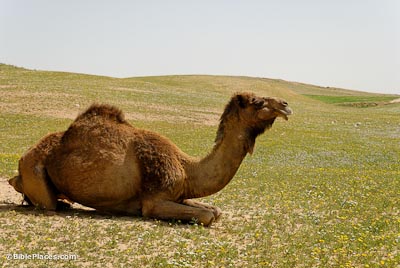
Camels
Oryx
The oryx (Hebrew re’em), or aurochs, is an herbivore known for its two straight horns. A type of antelope, the oryx lives in herds and moves about the desert in search of food, and like other desert animals, it can endure long periods without water. Although it does come from the same family as the wild ox, the NIV rendering of the oryx as a “wild ox” is inaccurate. By 1973, there were no oryx living in Israel. Today, 80 oryx are at Haibar Nature Reserve.
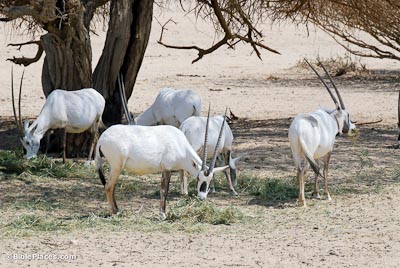
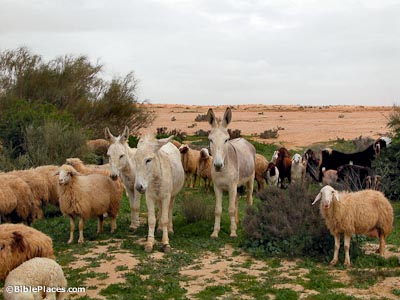
Donkey
The donkey was the common beast of burden throughout biblical times. Female donkeys could be ridden or milked, and males were good for plowing and trampling seed. Like camels and many other desert animals, donkeys can tolerate significant water loss (though not as great as the camel) and are able to replenish that loss quickly. This is because their sweat contains a low concentration of chloride. When the animals re-hydrate, their chloride level therefore remains the same, not needing to be replenished by the water.
Ibex
The ibex (Hebrew ya‘el), also called a “rock goat” or “wild goat” (KJV), is a large species of wild goat that feeds on green shrubs and chews its cud (it is a ruminant). Ibex are dependent on water and make their homes near water sources. One member of the herd will keep watch and whistle if danger approaches. The cliffs provide safety for the ibex because its strong, agile legs and grooved hooves allow it to climb the rocks in difficult areas. Its hooves are like sheep hooves but are hollow underneath with a ridge surrounding them, and its forelegs are shorter than its hind legs. This male ibex is identifiable by its goatee, long, curving horns, and heavy body.
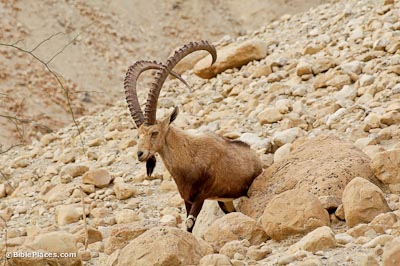
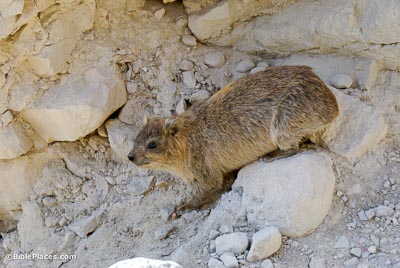
Hyrax
The Syrian coney, also known as the hyrax or rock badger (Hebrew shaphan) looks like an overgrown guinea pig. It can easily move about on rocks and difficult terrain because its feet have built-in suction. Its diet consists of plants and various grasses, but although it does have a three-part digestive tract, it does not ruminate. As is necessary for survival in the desert, the coney can maintain water well, but has difficulty with direct heat and thus hides in the rocks.
Jackals
Jackals are frequently referenced in judgment passages in Scripture as a wild animal that inhabits a place abandoned by man.
Isaiah 34:13 (NIV): “Thorns will overrun her citadels, nettles and brambles her strongholds. She will become a haunt for jackals, a home for owls.”
Job 30:29 (NIV): “I have become a brother of jackals, a companion of owls.”
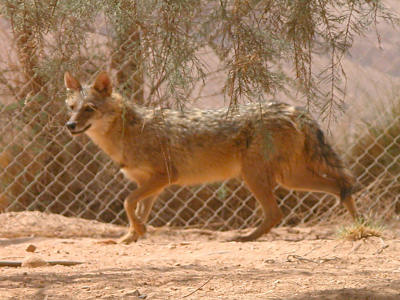

Download all of our Cultural Images photos!
$34.00 $49.99 FREE SHIPPING
Related Websites
For information on one of the most important animals in the Bible, see our Sheep and Shepherds page. To learn more about animals that make their home in the southern reaches of Israel, see our Southern Wildlife page. For historical images of camels, see Life in the Holy Land.
The Land: Nature (Israel Ministry of Foreign Affairs) This page offers a nice sampling of information about Israel’s flora and fauna, and is especially helpful in its description of recent conservation work in the country.
Check Out Israel’s 10 Most Unusual Wild Animals (Israel21c) Featuring photographs of each animal, this article is a unique look at some of Israel’s fascinating fauna.
Bible Animals: From Hyenas to Hippos (Bible History Daily) An article that offers a nice overview of biblical animals, drawing a contrast between animals that were in the land in biblical times and animals that are in the land now.
Israeli Birding Centers Project (official page) This website is dedicated to the birds of Israel, and it has many pages dedicated to various species here. The pictures alone are worth a look.